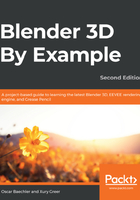
Modeling the base of the time machine
The base of the time machine is quite simple: it's a circle with a few extrusions in the middle and some clamps around the rim. Let's get started:
- Reset the 3D Cursor to the center of the grid (Shift + S hotkey | Cursor to World Origin).
- Go to the top view.
- Bring up the Add menu (from the top of the 3D View or with the Shift + A hotkey).
- Choose Mesh | Circle.
- Set Vertices to 64.
- Set Radius to 2.22 m.
- Set Fill Type to Ngon.
- Rename the circle Base.
Having more vertices in a circle will make it look more round and avoid us having a jagged edge look. Since this circle is so large, we need a lot of vertices to make it look nice. 64 is a good choice because it is a power of 2 (2 -> 4 -> 8 -> 16 -> 32 -> 64). Generally, we will get good results when working with nice, even numbers like this. Now, let's give it some thickness:
- Go to the side view.
- Tab into Edit Mode.
- Select the entire mesh.
- Extrude the selection upward to meet the first ridge.
- Extrude again to meet the second ridge.
- Scale down to match the thickness of the inner circle.
- Extrude up one more time to meet the topmost edge of the base.
Our base piece should look as follows:

Good – now, we just need the clamps. We'll start with a cube; however, the clamps are part of the base, so it will work nicely if all of their polygons are included inside of the same object that the circular part of the base that we just created is a part of.
If we use the Add menu to add a cube while we are still in Edit Mode, we won't see a new object appear in the Outliner. Instead, new polygons will be added inside of the Base object which we are currently editing:
- Go to the top view.
- Remain in Edit Mode, bring up the Add menu, and choose Cube.
- Set Size to 0.43 m.
- Set Location X to -1.89 m.
- Set Location Z to 0.32 m.
That's a good start. Now, let's align it to the front view:
- Go to the front view.
- Switch to Face Select mode.
- Grab the rightmost face and drag it to the left until it aligns with the edge of the clamp shown in the following screenshot.
- Grab the topmost face and drag it down until it aligns with the edge of the little corner shown in the following screenshot:

The next bit of this process should feel familiar since it's the same process we used to model the bulbous part of the armrest in the previous chapter:
- Extrude the top face up to the bend in the clamp (see the following screenshot).
- Scale down along the x-axis to match the reference.
- Extrude up again to meet the height of the circular piece of the base.
- Scale down along the x-axis to match the reference.
- Extrude up one more time to meet up with the top of the clamp.
- Select the right-hand side face of this latest extrusion and extrude it out to the right until it meets up with the edge of the clamp in the reference.
- Switch to Edge Mode and select the top-left corner edge (it's hard to see it from this angle, so rotate the view if you need to and then return to the front view once it's selected).
- Move the corner along the x-axis so that it matches the corner in the reference:

Don't forget to lock to the appropriate axes during these steps; otherwise, you'll shrink the cube along the other two axes as well. If we look at it from the perspective view, our clamp should look like the following:

Now, we just need to adjust the width at each of the extruded sections and we'll be done:
- Switch to Face Select mode.
- Select the two faces at the very top of the clamp piece.
- Go to the Select menu and choose Select More/Less | More:

- Go to the top view.
- Scale down along the y-axis to match the reference.
- Go to the Select menu and choose Select More/Less | More again.
- Go to the Select menu and choose Select Loops | Select Boundary Loop.
- Scale along the y-axis so that it matches what we can see in the following screenshot:

Good – the first clamp is finished. Now, we just need to place copies of it around the rim of the base to make the other seven clamps. We have a special tool in the Toolbar that can help us with this:
- Select any component on the clamp piece.
- Go to the Select menu and choose Select Linked | Linked.
- Activate the Spin tool from the Toolbar.
- Click and drag one of the blue widgets to begin the spin.
- Let go of the widget (precision doesn't matter here; we'll type in specific parameters in a moment).
- Open the Adjust Last Operator panel.
- Set Steps to 8.
- Set Angle to 360.
- Tab back into Object Mode:

Excellent! The base is finished. Now, as long as we still have our internal reference images set up, we can go ahead and model the remaining internal piece: the clock.